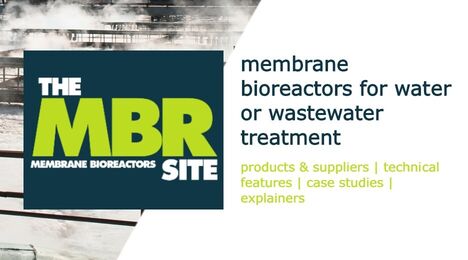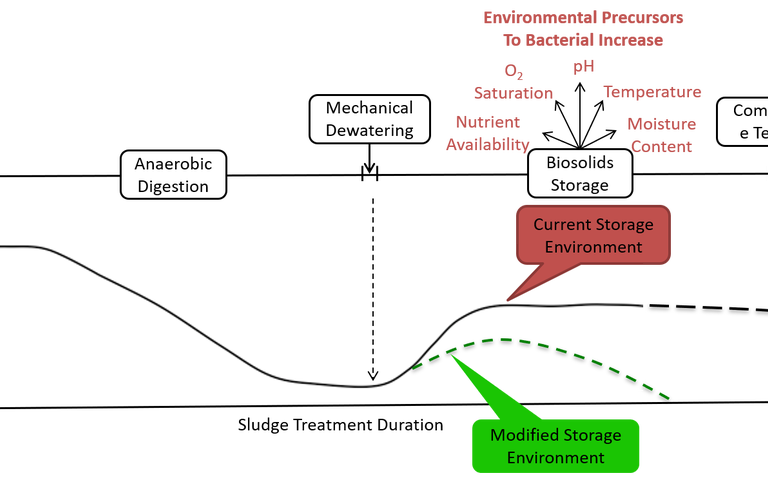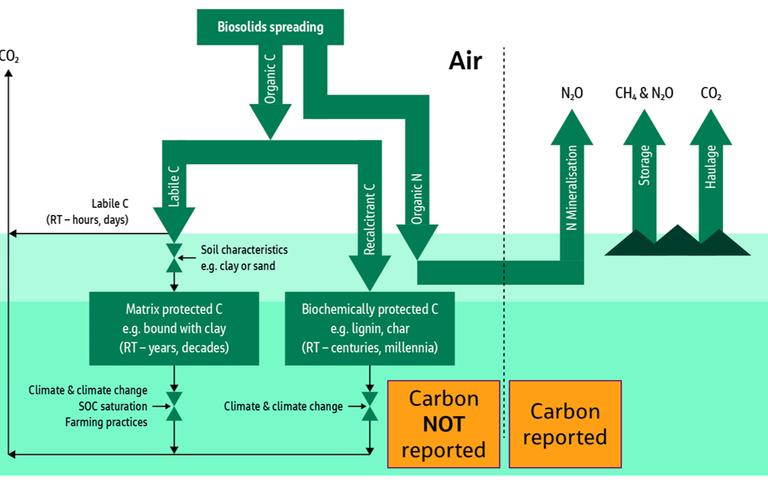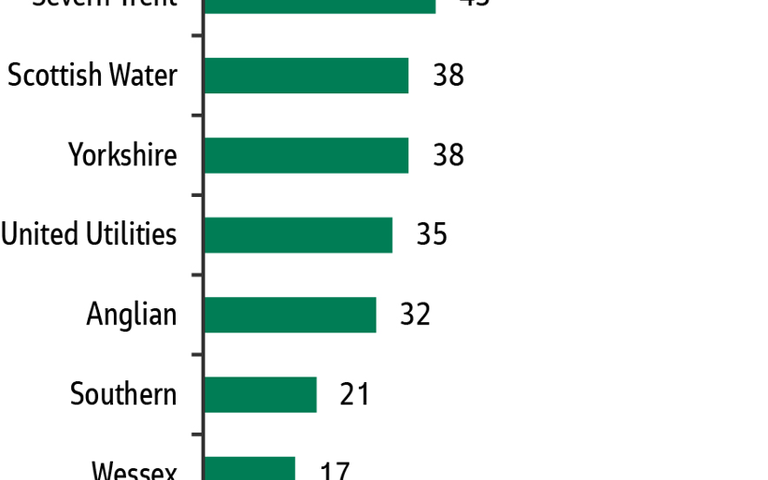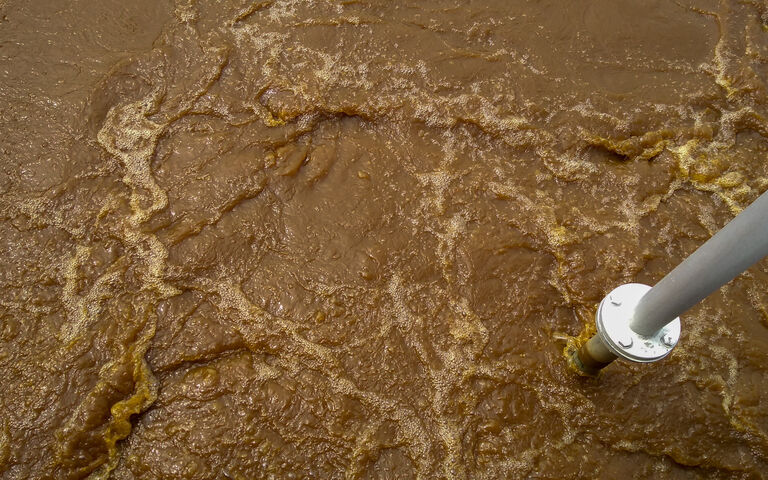Biosolids vs sewage sludge

Simon Judd
Professor Simon Judd has over 30 years’ post-doctorate experience in all aspects of water and wastewater treatment technology, both in academic and industrial R&D. He has (co-)authored six book titles and over 200 peer-reviewed publications in water and wastewater treatment.
In his capacity as director of Judd Water & Wastewater Consultants, Simon is co-owner of SludgeProcessing.com, as well as of our sister website The MBR Site. He is Professor in Membrane Technology at the Cranfield Water Science Institute at Cranfield University in the UK where he has been a staff member since 1992. Simon was also a Research Chair at Qatar University in the Middle East for six years until September 2018.
What are biosolids?
The terms ‘biosolids’ and ‘sewage sludge’ are often used interchangeably. However, biosolids are usually considered to be the useful fraction of the sewage sludge. They are generally higher in solids concentration and lower in pathogen content, having gone through a stabilisation process such as chemical dosing, digestion and/or drying.
There are, however, different classes or categories of biosolids, determined by legislation, and linked to the end use or disposal − and specifically for applying to land. In many countries, there are different criteria set with reference to the most onerous biosolids constituents (in terms of human health and environmental impact) for different types of land applications.
United States of America
In the USA, biosolids − around 50% of which are disposed of to land − are categorised as 'Class A' and 'Class B'. The requirements for these two classes are defined under the national regulation 40 CFR Part 503, though there may be more stringent requirements or additional criteria imposed by individual states.
Class A biosolids must have non-detectable levels of pathogens (specifically faecal coliforms and salmonella) as well as levels of metals, odours and vector attraction reduction (VAR) within the thresholds stipulated by the USEPA Part 503 Rule. VAR refers to processing of the biosolids to make them less attractive to 'vectors', a general term for any species (insects, rodents or birds) which can promote transmission of disease from the biosolids to humans. The USEPA also sets concentration limits for ten metals in Class A biosolids, ranging from 75 for arsenic to 4300 mg/kg DS (dry solids) for copper.
Various stabilisation processes can be used to meet the Class A quality criteria, including:
- anaerobic digestion (AD)
- aerobic digestion (composting)
- alkaline stabilisation, and
- thermal hydrolysis.
This class of biosolids can then be legally used for all land applications without restriction. There is additionally the term Class A EQ (Exceptional Quality), used to describe a biosolids product that not only meets but exceeds all Class A pathogen, metals and VAR requirements.
Class B biosolids also comprise treated sewage sludge but contain higher pathogen levels than Class A biosolids, restricting their land application to those with a lower associated human health risk (i.e. those with limited risk of human contact). A survey of Class B biosolids generated at various sites in the US conducted more than a decade ago (Pepper et al, 2010) indicated 94-99% reduction of both indicators and pathogens by anaerobic mesophilic digestion for all organisms. There is nonetheless an increasing shift away from Class B biosolids generation and toward Class A and Class A EQ, due to the implementation of more advanced biotreatment technologies.
European Union
EU legislation defining limiting concentrations of metals in biosolids intended for land application was introduced in 1986. As with the US, land spreading remains the primary disposal route in the EU. However, there are considerable differences in the preferred biosolids management option across the different member states (Fig. 1).
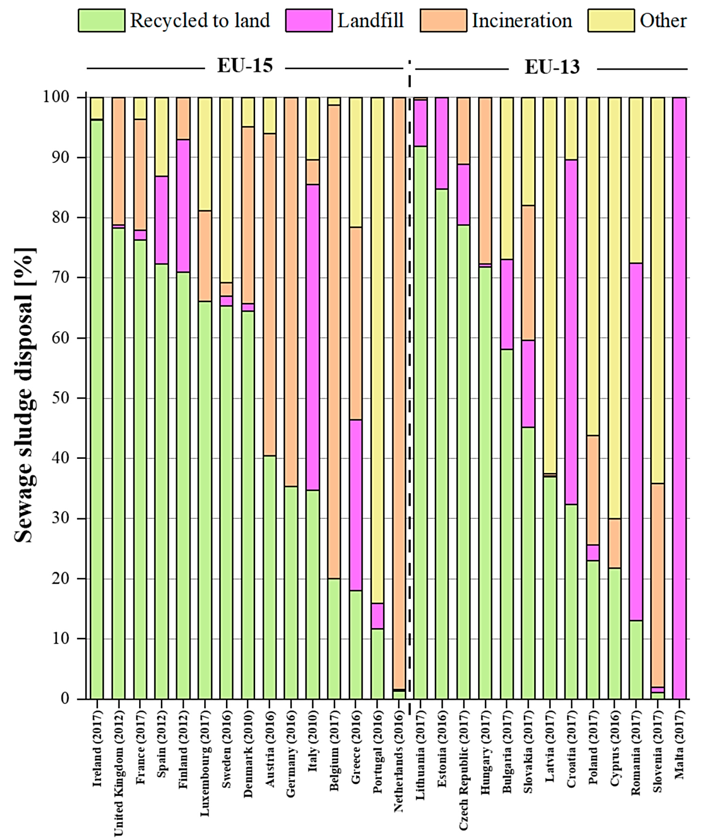
In countries such as the Netherlands where land disposal is precluded to a large extent by public acceptance, around 98% of the biosolids are incinerated. Incineration is also the primary disposal route in Germany, accounting for more than 60% of the generated biosolids. In Ireland and Lithuania, on the other hand, more than 90% is applied to land − predominantly in green areas and forestry.
Unlike the US, there remains no EU-wide regulatory limit on pathogen concentrations. Instead, each member state imposes its own limits. These vary in both the pathogen indicator used and stringency with reference to its permitted concentration. The most commonly-used reference pathogen appears to be salmonella, ranging in concentration from undetectable in 100 gDS to 8 MPN (most probable number) per 25 gDS.
As with permitted pathogen levels, there exists a wide range of values for the limiting metals concentrations imposed by the different member states, many of which are more stringent than those imposed by the EU (Table 1). For example, the maximum permitted concentration of mercury is 20 times higher in Portugal than in Denmark. These two countries also both have statutory limits for four specific micropollutants, supplementary to the metals stipulated by the general EU legislation.
| Metal | US | EU | Denmark | Germany | Portugal |
|---|---|---|---|---|---|
Sources: Collivignarelli et al, 2019; Sonon and Gaskin, 2017 | |||||
| Cadmium | 85 | 20−40 | 0.8 | 10 | 20 |
| Chromium | 3000 | − | 100 | 900 | 1000 |
| Copper | 4300 | 1000−1750 | 1000 | 800 | 1000 |
| Lead | 840 | 750−1200 | 120 | 900 | 750 |
| Mercury | 57 | 16−25 | 0.8 | 8 | 16 |
| Nickel | 420 | 300−400 | 30 | 200 | 300 |
| Zinc | 7500 | 2500−4000 | 4000 | 4000 | 2500 |
Summing up: the challenges
There appear to be considerable regional/national inconsistencies in the standards adopted for biosolids quality. These can be attributed to a number of different factors, including policy (linked to public perception), climatic conditions and land availability. It is also the case that soil conditions have a significant impact on the fate of the individual pollutant species, though there is no prospect of legislating for this factor due to its complexity.
A very significant unknown is the long-term fate and impact of those micropollutant species already recognised as being potentially harmful in water. So far, few countries have introduced standards for these species in biosolids or soil, and then only for a limited number. Analysis of these species presents a further challenge: detecting micropollutants in solid media is not as straightforward as it is for water, for which the analytical methods are more established and simpler.
Lastly, there is always likely to be a change in scope with reference to contaminants of concern. These include micro/nanoplastics, antimicrobial resistant genes (ARGs) and, just within the last year, viruses (and no prizes for guessing which one in particular). The fate of ARGs in wastewater and sludge, and specifically the AD process, has become an established area of research (see Anaerobic digestion and antibiotics/ARGs – ten research papers). As a research topic, sewage sludge as a possible source of microplastics in soil barely existed little more than five years ago, but there were at least 20 papers on this subject published in 2020 (according to the SCOPUS database). And, naturally, the fate of specific microbial species in municipal wastewater and sludge has extended to COVID-19 within the past 12 months.
So there is an inexorable drive towards ever more advanced treatment of sludge, both to capture the embedded resource and render the bulk material harmless. Thermochemical technologies for achieving these two key goals already exist, and are considered economically viable at a sufficiently large scale. Perhaps a key game-changer, therefore, would be to make these processes viable at a smaller scale – perhaps for those small (and still rare) decentralised installations we’ve all been talking about for years.
Because after all, as E.F. Schumacher insisted to great effect almost half a century ago, small is beautiful.

